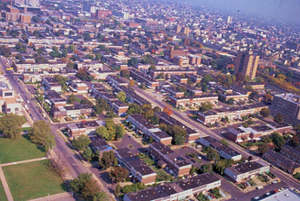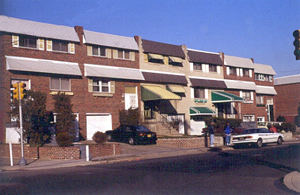
Yorktown was one of several Philadelphia areas considered for large-scale redevelopment during the years after World War II. In 1950, the City adopted an urban renewal plan which called for demolishing all structures and rebuilding new housing. Eight years later, nine city blocks had been acquired and cleared by the Redevelopment Authority of the City of Philadelphia and sold to Norman Denny, a developer with a successful record in production of for-sale housing at many sites in Northeast Philadelphia and the suburbs.
Many African-American religious and civic leaders played key roles in the planning, development, marketing, and organization of the Yorktown community. One of these leaders, the Reverend Dr. William H. Gray, Jr., pastor of Bright Hope Baptist Church, was quoted in the January 3, 1963, Evening Bulletin: "This is the first time and place in the United States that Negroes have been named as developers for urban renewal. We think we can make a significant contribution to the city here."
The Yorktown venture was designed as one element of a larger community plan that included "affordable" rental housing, the Progress Plaza shopping center at Broad and Oxford Streets, and the Bright Hope Baptist Church and Youth Center at 12th Street and Columbia Avenue (now Cecil B. Moore Avenue). In Yorktown, the developer constructed two- and three-story attached single-family houses on 1,600-square-foot lots. Housing density was reduced to about half the level which had previously existed. The new houses had three or four bedrooms, with garages and car pads as standard features. Edmund Bacon, then executive director of the Philadelphia City Planning Commission, designed a new street layout with a contiguous series of cul-de-sacs, limiting through traffic and creating a quiet residential environment without separating Yorktown from the rest of the cityscape. Today, Yorktown remains an attractive, appealing neighborhood, with a substantial number of middle-class families and retired people, many of whom are the original buyers.
- In
the book Neighborhood Recovery,
John Kromer compares Yorktown's development with that of with
present-day neighborhood reinvestment (Chapter 1, "A Strategic
Problem").
www.neighborhoodrecovery.com
- For
information about Yorktown, contact:
Executive Director
Yorktown Community Development Corporation
1300 West Jefferson Street
Philadelphia, PA 19122
215/769-0225 voice
215/763-4884 fax
Philadelphia Association of Community Development Corporations
1314 Chestnut Street, 7th Floor
P.O. Box 22641
Philadelphia, PA 19110
215/732-5829 voice
215/732-5725 fax
www.pacdc.org - For
a copy of the 1996 publication Learning from Yorktown, contact:
Public Information Department
Office of Housing and Community Development
1234 Market Street, 17th Floor
Philadelphia, PA 19107
emily.romin@phila.gov
![]()


TOP • NEXT PAGE • LIST OF TOUR STOPS • MAP • P.N.R.T. HOME • YOUR COMMENTS